Best Weeding Tools: Guide & Recommendations
We independently evaluate all recommended products and services. If you click on links we provide, we may receive compensation.
Weeding is probably one of the most disliked gardening tasks, usually because it’s hard work and the job never seems to be finished (remove one weed and two more will spring up in its place!).
So what's the best way to remove weeds from your lawn and garden?
There’s no simple answer; the best method and/or tool depends on a number of factors –
- you (for example, your hand strength and dexterity, ability to kneel and reach, how much time and patience you have)
- the type and number of weeds (such as weeds with long taproots, large rootballs, runners or stolons, size, woody versus soft, annual versus perennial)
- conditions (soil type and moisture level, where the weeds are e.g., garden bed, between patio pavers, climbing up a tree), and
- preferences (for example, organic vs mechanical vs chemical).
Reasons to Weed
Whether you're a laissez-faire gardener like me or one who likes everything to look perfect, you'll still need to weed your garden from time to time. Here's why.
- Weeding keeps your garden beds tidy and, more importantly, keeps your plants healthy.
- Weeds inhibit plant growth by competing for moisture and nutrients in the soil. If you don't weed, your "real" plants may decline or be overrun.
- Weeds can ruin the look of your carefully-planned garden. Think of yellow dandelions instead of the blue salvia you were expecting to see...
- Some weeds are poisonous or cause skin irritation (e.g., poison ivy, giant hogweed).
- Invasive plants can get out of control.
- Once established, weeds are hard to remove without damaging your plants.
How to Prevent Weeds
Although there’s no way to “weed proof” your garden, there are a number of ways to reduce the number and vigor of weeds. Some of the most common methods include:
- Intensive cropping / planting densely
- Covering the soil with mulch (including organic mulches, such as shredded bark, pine straw, or compost, and inorganic materials, such as gravel, rubber mulch) or a weed-suppressing layer (fabric, plastic)
- Spreading a chemical weed suppressant on the soil surface
- Deadheading or removing all weeds before they go to seed
Still, no matter how diligent you are in trying to prevent weeds, there will always be the ones that "got away" - and you'll have to find some way to remove those weeds.
Types of Weeding Tools
While hand pulling is the simplest method, it’s only effective against smaller weeds with shorter roots. It also assumes that you’re able to spend extended periods of time on your knees, reaching for and pulling weeds. For anything else, you’ll need a weeding tool of some kind.
Two Types of Weeding Tools
There are two basic styles of weeding tools – short handled and long handled. Short-handled tools are best for working on your knees in tight or closely planted areas. Long-handled tools allow you to stand while weeding and cover a larger area.
Within these two basic styles, you’ll find a huge variety of designs. Manufacturers have come up with all sorts of tools to remove weeds. Some work very well, others are mostly gimmicks.
No tool is perfect for all weeding tasks so you’ll likely end up with several different types of tools. The key is to find the ones that best allow you to do the kind of weeding that’s necessary for your garden or lawn.
Here’s what you need to know to choose the best weeding tool for your needs.
What to Look for When Buying Weeding Tools
When considering a new weeding tool, ask yourself the following questions:
- Does this tool allow me to work in a comfortable position? Can I hold it easily? Do I have the strength and/or dexterity to use it properly?
- Can it pull out the entire root? How about for weeds with longer or deeper roots (as deep as 6 to 12 inches or greater)? This is especially important for taprooted weeds – miss even a little piece of root and the weed will spring back quickly.
- Will it work for the most common and/or troublesome weeds in my garden? For example, if you have a lot of running grasses, can it pull out the roots without breaking them into little pieces? If dandelions are your problem, can it pull taproots?
- Is this weeding tool made with high-quality materials, such as a hickory handle or stainless steel blade? Are the parts held together securely? And does it have a warranty?
- Are the cutting or digging edges sharp? Can they be resharpened if needed?
- What kind of maintenance does this tool require? Does it need frequent cleaning, lubricating, or sharpening? Am I prepared to do that?
- What else can this tool help me with? And if I get this weeding tool, what other tools will I also need to be able to do all the necessary weeding tasks in my garden?
- Given all of the above, is this really a tool that I’ll use? Will it make weeding easier, or will it just complicate things?
Only you can answer these questions and the answers will be different for everyone. With so many weeding tools to choose from, use your answers to help guide your buying decisions. Don’t be sucked in by slick marketing material and TV ads – just because a tool seems to work for someone else doesn’t mean that it’s the right tool for you.
Short-Handled Weeding Tools
Short-handle weeders are more than just a smaller version of long-handled weeding tools. Although some do look like miniature hoes, there is also a wide range of unique styles only found with short handles. The goal is to give you good control of where you make your weeding strikes (so you don’t accidentally uproot your prized perennials) with enough power to make the job as easy as possible.
Depending on your needs, one or more of these short-handled weeders may be just what you’re looking for.
Hori Hori or Japanese Farmer’s Knife
This versatile tool looks like a knife on steroids. The 7-inch blade has one smooth edge for slicing (like when opening a bag of mulch) and one serrated edge for use in stabbing and sawing through roots, sod, and other tough material. It can be used for cultivating, digging, cutting, and prying weeds out of the ground. It’s usually available with either a stainless steel or carbon steel blade. While the carbon steel holds a sharper edge, it needs more frequent sharpening and rusts quickly. You can usually find a decent hori hori (such as the one in our review below) for around $25.
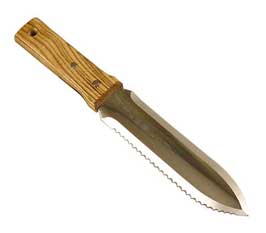
Lesche Digging Knife
There are few gardening tools I absolutely cannot be without - this is one of them. The Lesche digging knife is a beefed-up version of the traditional hori hori. It has a comfortable and sturdy handle, both a serrated and straight edge on the digging blade, a blade guard to protect your hand as you plunge the tool into the soil, and a heat-treated blade that’s strong enough to give you the flexibility to do far more than just weed. I’ve used it to easily slice through roots when weeding, cut through sod (I’ve even used it to edge a flower bed), dig trenches, weed between bricks or pavers, cut twine or plant ties, pry up pavers and rocks, and so much more. It even comes in both right and left-handed versions. Made in the USA. You won't find this in retail stores so buy it online where it costs about $36.
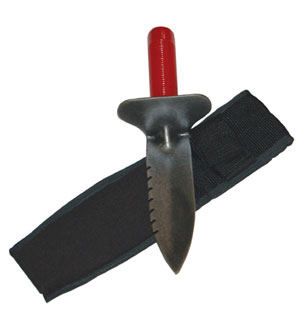
Asparagus Knife / Fishtail or Dandelion Weeder
You’ve probably seen many of these before – it’s the tool commonly used to pry up dandelions. While I tend to use my hori hori or Lesche knife to dig up taprooted weeds in the flower or vegetable beds, there’s nothing like a fishtail weeder for getting dandelions out of lawn or groundcover. It has a long, narrow shaft with a V-shaped tip. Just plunge it into the ground beside the dandelion with the V facing the plant, pull back slightly on the handle, and voila – the dandelion will pop out easily. This isn’t a “sexy” tool, but it’s a must-have. And if you want to go "upscale" there's a version with a fulcrum that could make it even easier to pop weeds out of hard ground. You'll find a wide range of prices on dandelion weeders, from about $5 all the way to $40. There are also ergonomic versions (mostly with larger handles) for those with dexterity or grip strength issues.

Cape Cod Weeder
This is a strange-looking tool but it comes in handy when working in tight spaces. The L-shaped blade is drawn toward you right under the soil surface, cutting off weeds at the root. It’s short enough to let you easily reach between plants and is easy to hold. Make sure you get the right one though – it comes in both a right- and a left-handed version. Depending on the brand, prices range from $20 to $50.

Hoe Dag
Yes, the hoe dag. I’m not sure what the name means, but the tool itself means business! With a beech handle and a heat-treated carbon blade that looks a bit like a miniature pickaxe, the hoe dag is an extremely versatile tool that I use for weeding, digging, planting, cultivating, removing clumps of grass, and more. Use the larger end of the blade for digging and planting, and the smaller end for more controlled actions, like weeding. It’s easier on the wrist than many weeding tools because it doesn’t require you to twist or bend your wrist – just bury the head in the ground and pull it toward you. Made in the USA. Retails for under $40. I've never seen it in a store so buy it online.
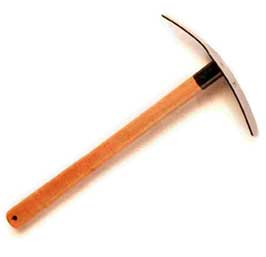
CobraHead Weeder
With a handle made from recycled plastic and a tough metal blade that doesn't seem to rust (mine's been outside for many years without rusting), the CobraHead weeder is made to last. Any way you use it, the curved blade on the CobraHead effortlessly digs into the soil. The weighted collar that holds the blade helps the blade sink into the soil quite naturally, whether you're gouging roots of weeds or just loosening the soil. It's great for working in-between plants and can easily pull out larger weeds with the rootball intact (it's great for pulling up large clumps of grass). It's made in the USA, costs about $25 and is available in both a regular and mini size. There's also a long-handled version.
See our review of the Long-Handled CobraHead here >>

Long-Handled Weeding Tools
This is a category of tools in which you'll find many gimmicky items that just don't work. If you've ever seen an infomercial promising to "make weeding so much fun that even the kids will love it!" then you know what I'm talking about.
We're still in the process of testing every weeding tool that looks like it might be worth purchasing and I'll continue to update this article as more reviews are completed. In the meantime, here are the long-handled weeding tools that we highly recommend.
Dutch Hoe
A Dutch hoe differs from the traditional American hoe you're probably familiar with. It's used by resting the lower end of the blade flat on the ground and gently sliding the hoe back-and-forth. The blade will slip under the surface of the soil to break it up and cut the weeds from their roots. By working backward from one end of a bed to the other with a push-pull action, hoeing becomes an easy task. The long handle and easy motion required of this hoe allow you to stand upright without bending over, saving your back as well as time. Prices for a well-made tool, with a solid oak handle, stainless steel blade and lifetime guarantee range from about $55 to $80.
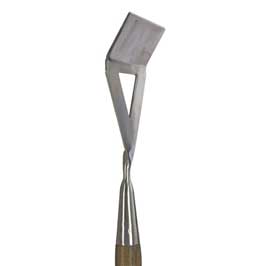
Oscillating Hoe or Stirrup Hoe
This is another hoe that's quite different from a traditional American hoe. Instead of a solid blade, it's stirrup-shaped (hence the name stirrup hoe). The bottom of the stirrup is flat and sharpened on both sides; it's the part of the hoe that does all the work. Simply place the blade on the soil surface and move it back and forth (push and pull it like you would a vacuum cleaner). The blade will dig in just below the surface and cut off weeds at the root. As an added bonus, it also cultivates the soil as you move it. This type of weeder is generally lightweight, easy to use, and maneuverable (so you can use it in tightly planted garden beds). The handle is usually wood or fiberglass and prices range from $25 to $50.
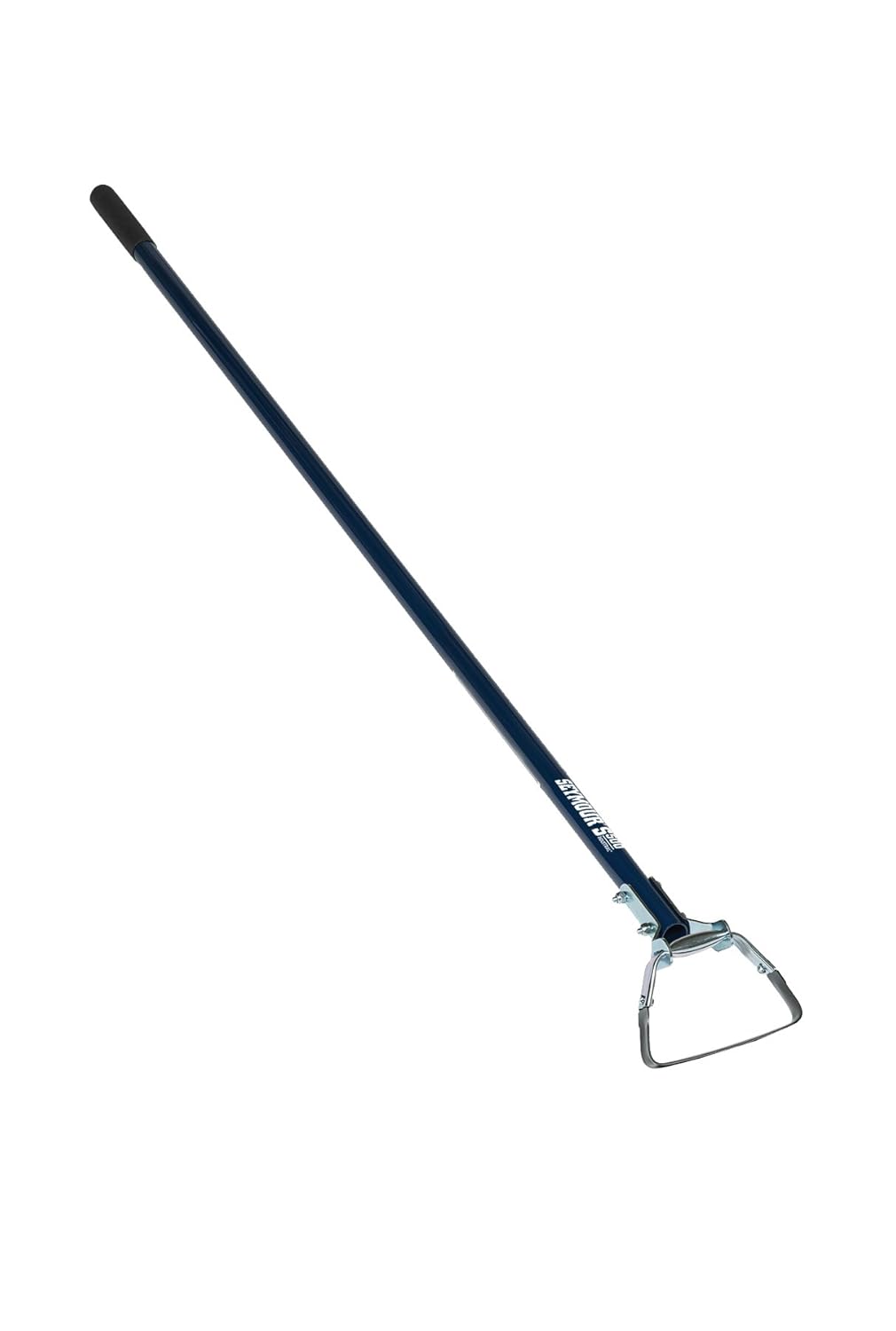
Radius PRO Weeder
This ergonomic weeder has a circular, resin-coated handle that's perfect for those of us with arthritic fingers, grip strength issues, carpal tunnel or any other hand/wrist problems. The long, stainless steel blade easily slides into the ground when you step on the foot rest. It's particularly good at uprooting taprooted weeds - say goodbye to dandelions and dock! It's made of resin-encased steel and has a lifetime guarantee. Note that it weighs in at 4.5lbs so it's a little on the heavy side.
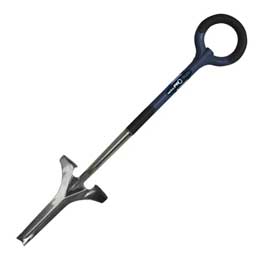
Scotts Weed-Out PRO
I've always been skeptical of stand-up weeders - they make a lot of promises but many are flimsy tools that don't get the job done. But the WeedOut Pro from Scotts puts that stereotype to rest. It does an excellent job pulling weeds in garden beds and lawns. The only time you'll have to bend over or kneel down is to pick up the weeds after they've been ejected from the tool (assuming you don't eject them directly into a bucket or tub trug). It’s sturdy, lightweight and easy to use. This will save a lot of pain to the back, knees and hands and has the bonus of aerating the soil at the same time.
Weed Dragon Garden Torch
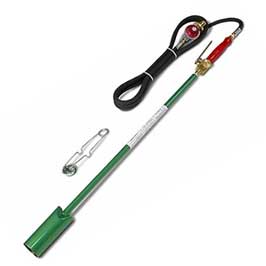 OK, maybe this doesn't exactly fall into the "long-handled" weeding tools category, but it sure gets the job done and you don't have to bend over to do it. The Weed Dragon emits a flame that's used to "cook" weeds, destroying their ability take up water and nutrients; eventually, they die. While it doesn't kill weeds immediately (some weeds can take several days to die), it's highly effective and requires very little effort. Just be sure to have someone standing by with a garden hose in case you flame the wrong thing or something catches on fire (that's a rare occurrence, but it's better to be safe than sorry).
OK, maybe this doesn't exactly fall into the "long-handled" weeding tools category, but it sure gets the job done and you don't have to bend over to do it. The Weed Dragon emits a flame that's used to "cook" weeds, destroying their ability take up water and nutrients; eventually, they die. While it doesn't kill weeds immediately (some weeds can take several days to die), it's highly effective and requires very little effort. Just be sure to have someone standing by with a garden hose in case you flame the wrong thing or something catches on fire (that's a rare occurrence, but it's better to be safe than sorry).
And now over to you - What's your favorite weeding tool? Why? Share your thoughts in the comments below!
Enjoyed This Review?
If you liked this review, please sign up for our email updates with reviews, how-to articles and gardening videos!

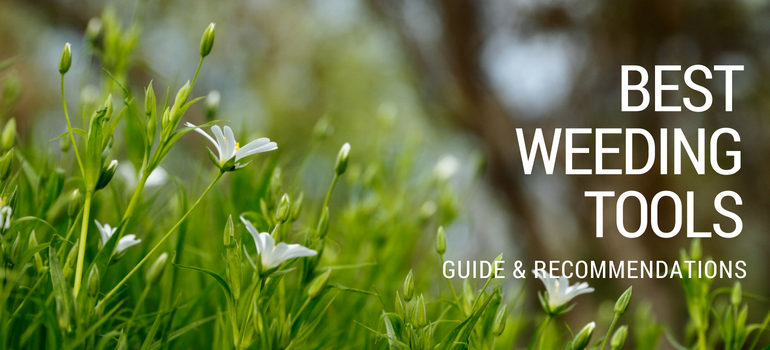
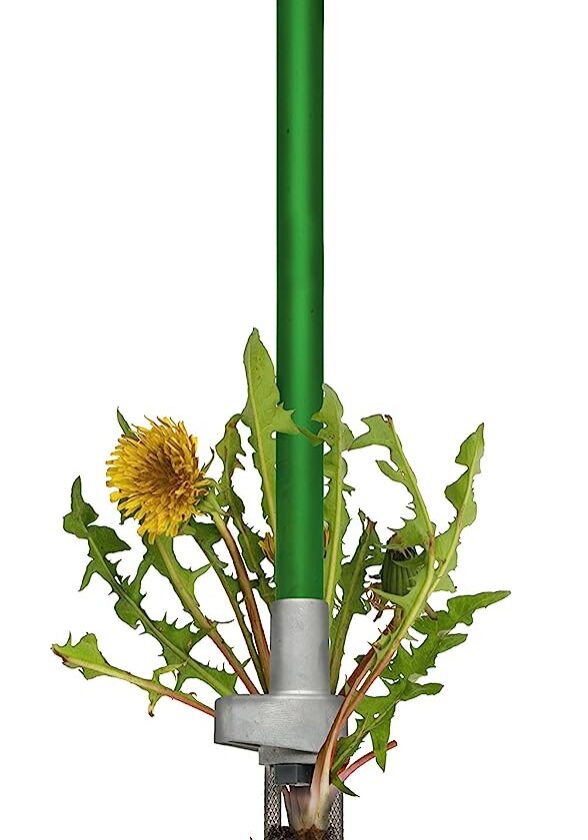


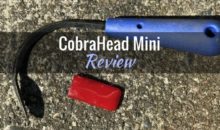
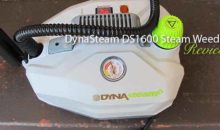
I’ve Had Great Success With intensive Methods…Plant Really Close, Block Out Sunlight For Weed Seeds….Where There Is a Space Weeds Will Come. I Rarely Need To Weed My Perennial Beds….Easy. Understanding What Pants Can outcompete Your Weeds Helps..Much Research In That Area. I do find weeding relaxing however, clears my head and encourages creativity. Also, not disturbing the soil or letting your weeds set seed helps. Most people wait until the wind has Spread the seeds..So they end up with 1000 more the following year. Thanks For This Post.
Thanks for the suggestions, Louise. Like you, I tend to plant close to block out weeds – it works well if you choose the right plants (i.e., ones that won’t get powdery mildew or other problems from less air circulation). People don’t believe me when they look at my garden and I tell them it’s low maintenance – requires very little weeding or watering.
I have boxed raised beds in my garden because I live in the NC mountains where the soil is very rocky & mostly clay. My favorite weeding tool (other than my hands…lol) is the Hula Hoe which goes below the surface of the soil but doesn’t dig up the soil. I’ve also been checking out the COBRA weeder though & thinking I might give that a try this year. :~)
I love the hula hoe too! (also called a stirrup or oscillating hoe) I use it throughout the garden on a regular basis – although I don’t think it’s going to be much use in my new garden in Tucson, AZ where there’s nothing but gravel… I think you’ll also like the CobraHead – we reviewed the long-handled version here: /cobrahead-long-handle-weeder-review/
Hello, I am specifically looking for any kind of hand tools that are advantageous for people with impaired dexterity or vision. For example, I ordered a weeder that was advertised as “no bend weeder” and there were so many parts that needed to be assembled and after 45 minutes, I thought it was correct, only to find one part was put in wrong, so the darned thing would not work. I sent it back.
I’m new to your site. Do you have an archive of articles that may cover hand tools for senior gardeners?
Hi Toni and welcome to GPReview!
It sounds like you had an awful experience with that “no bend weeder”. So many times the marketing and ads make a tool look like a perfect solution, only to find that it’s practically useless… Can you share with us what brand that was?
I haven’t classified the tools we’ve reviewed as being ergonomic or suitable for those with dexterity or flexibility issues – perhaps I should. The Hand Tools archive can be found here: /category/hand-tools/. Some of the tools, just as the HERShovel, are designed for women or those with limited strength. You may find some helpful tools there.
Does anyone out there weed horizontally?
The ‘recumbent’ position is relaxing and offers an intimate plant’s eye view of its surroundings. . Since there’s no soil showing and plants all over, not in beds, it’s’ not really dirty. Bulbs do get flattened a bit, but I’m considering a large dog cot.
BTW, you are really doing us a great service with your thorough, thoughtful reviews, Monica. Thanks.
I haven’t tried this, but a rose expert just talked about using a dutch hoe for weeds. He’d had hip surgery and couldn’t bend over. It has a sharp edge which you push forward just under the surface to cut the root off the green weed.That’s all you do; you don’t even need to pick up the weeds. Sounds wonderful to me.
I haven’t tried the Dutch hoe yet either but it looks like it would be an excellent choice (Sneeboer, care to send us one to review?). Has anyone else used a Dutch hoe?
I love the Dutch hoe, I used one at my previous workplace often. Since leaving there, I have not been able to find one to buy–glad to know where to get one! In the meantime, I use my ‘Winged Weeder’ that I’ve had forever. It’s very sharp and easy to control.
Perfect timing on your comment, Sue – we have a review of the Joseph Bentley Dutch hoe coming out on February 23rd. It’s a beautiful tool! We haven’t tried the “Winged Weeder” yet but have been hearing good things – hopefully we can get one to review soon. Here’s to defeating those pesky weeds!
As I become just *slightly* less willing and able to bend and twist, I like standing-use tools.
Along the lines of the Dutch hoe–I use a step-on weeder with a ~3-ft. handle that digs its teeth under a weed and yanks it out by the roots when you step down. It could stand some ergonomic tweaking: the handle is straight; could be curved for wrist comfort. But “arm stronger than hand, leg stronger than arm.”
The digging width is about 4″, which mostly prevents the user from digging into/under too much weed material and getting stuck (which is unpleasant–a bit like when a wheelbarrow stops suddenly). But it is very satisfying to annihilate hefty weeds.
And I have a retro, antique-by-now edger: a wood foot platform (helpfully painted with a footprint graphic), with a skate type blade underneath, hinged to a waist-height pole. Position just in front of you, push pole forward, step down, and voila! another ~8″ chopped. Maybe my feet are wide, but it’s possible to kind of trap too much of your instep under the pole frame and pinch it. Quite painful bu preventable by careful positiong of your foot precisely on the footprint outline…
Your step-on weeder sounds like a helpful weeding tool. I’ve seen several advertised but have never tried one – they always seemed a little “gimmicky” and I wondered if they’d really work. Glad to know that at least one gets the job done!
As for the edger – you wouldn’t happen to have a photo of that, would you?
Hi all,
I am a senior citizen and needed a stand up weed puller. I highly recommend the Fiskars Uproot Weed and Root Remover. All you have to do is place the tool over the center of the weed, step on the bottom of the tool to drive the blades into the ground around the weed and then pull back on the top of the handle and the weed, roots and all, easily comes out. I especially like the weed ejector part. You just pump the handle and the weed flies off the end of the tool onto the ground or into a container for disposal. To my amazement this tool also will pull crabgrass, etc. removing all the roots. Also, it pulls clump grasses easily. I have tried alot of weeding tools and this is the best by far, so far. The only caveat is the ground must be soft enough to penetrate but who in their right mind tries to weed when the ground is dry and hard. Anyway, thats my two cents worth.
Thanks for the recommendation, Gerald! I haven’t tried the Fisakrs weeder yet but have heard some good things. Looks like that’s another one we’ll have to add to our “To Review” list.
This sounds like just the kind of tool I was looking for. I live in the high desert (socal) and the house I just moved into has a large yard that is in danger of being completely overrun with baby tumbleweeds. From a distance, it almost looks like I have an actual lawn going on, lol. Fortunately, the ground is relatively soft and sandy, so I want to yank up all those little suckers before their roots get deep and they get huge and spiky and really turn into a pain in the ass to remove.
Hi everyone,
I highly recommend Grampas Weeder as one of the top long handled weed removers. The simplicity of the tool makes it easy for anyone of all ages to use and it requires only three basic steps to pull the weed out. The tool was the original in long handled weed removers and the lever design makes weed pulling easy and efficient. I appreciate the lack of work I actually have to put in when using this tool, it’s fantastic. It’s very similar to the Fiskars uproot weed remover, but the old fashioned brand feeling of the company and family orientated messages make me love this product more than any other one on the market. Plus, you can’t beat the lifetime guarantee on the tool. Just my opinion on the tool and I know many others feel the same way!
Thanks for the recommendation, Brandon. It’s always good to hear about what’s working for our readers. Sounds like we’ll need to test out Grampas Weeder!
What tool would you suggest for someone in a wheelchair?
Hi Dana. As with all tools, the answer is “it depends”. In this case, upper body mobility and grip strength would be important considerations, as would the type of gardening being done. Many people in wheelchairs prefer elevated beds for gardening (although of course that’s not always a feasible option) – in that case, any hand-held weeder that’s comfortable to use would work. If you’re gardening at ground level, then a multipurpose, long-handled tool like the CorbaHead would be a good choice – it’ll handle a lot of different gardening tasks so you don’t need to use multiple tools.
My favorite Garden tool is my Garden weasel Pro-Claw. Its so handy. Its really pulls weeds and arriates the soil. It requires some effort but its easy to get a rythm and wipe out weeds fast. The Garden weasel is a great garden tool.
Great post, I haven’t heard about the Asparagus Knife Weeder. Must give it a try next time I clean up the weeds in the garden. Right now I am using Fiskars Weeder (7060) and it seems to work well.
Keep it up
Zac
Thank you for recommendations. It’s one thing to read, another thing to see how it works. I share with you an excellent video, where clearly demonstrated how to remove dandelions. Video is here https://grass-killer.com/reviews/best-weed-pullers/
I live in Phoenix, AZ (hot and hard soil) and I am trying to rid my lawn of spurge weeds. I have spent hours bending over with my asparagus weeder but, the root does not always come out. Exhausting work. The root has to be removed or else it will grow back. Some of your reviews of the long handled weeders did not mention if it removes the root or not. Glad to have read some of the comments including the one about the Fiskars Uproot weeder as well as the Grampas weeder. I’ll give one or both of those a try.
Thanks for these tips,especially on what to look for before buying these weeding tools. Will help up a lot!
Glad it was helpful!